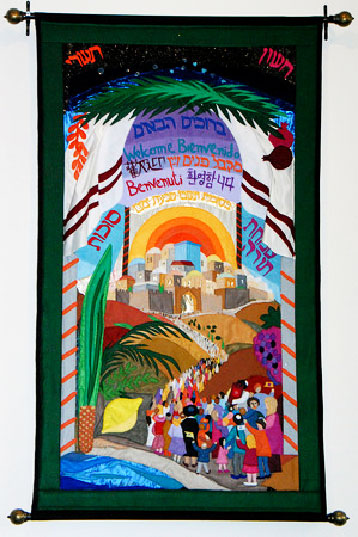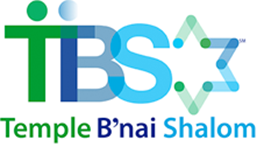Tapestry #2 Cheshvan: From Bitterness to Blessing
 From our blue Gates of Prayer p. 453:
From our blue Gates of Prayer p. 453:
According to our calendar, the month of Cheshvan begins on Wednesday night, November 2, 2005.
O Lord our God, let the coming month bring us renewed good and blessing. May we have long life, a life of peace, prosperity, and health, a life full of blessing, a life exalted by love of your Torah and devotion to your service, a life in which our heart’s desires are fulfilled for good.
O wondrous God, who in ancient days led our people from bondage to freedom, redeem us now out of our exile from one another, making all Israel one united people.
God of holiness, let the new month bring for us, and for the whole House of Israel, life and peace, joy and happiness, deliverance and comfort, and let us say: Amen.
Traditionally, Cheshvan has been called Mar Cheshvan. Mar means bitter, as you know Maror at the Passover seder is the bitter herb. Cheshvan is considered bitter because it is the only month of the Jewish year without a holiday. But, when we crafted and thought about our tapestries, we wanted to go from bitterness to blessing.
For those of you new to our tapestries, they were born with the idea that each tapestry would represent a Jewish value we treasure here at B’nai Shalom. The artists, Bracha and Menachem Lavee, of Jerusalem, asked if they could use as an organizing principle the twelve months of the Jewish year, as we commissioned twelve tapestries. It certainly was a wonderful idea and added a dimension of beauty and learning that enriched their design and our sacred space.
But, what do you do when there is a month with no holidays? Menachem suggested that we let this one tapestry share two months. The Jewish New Year begins with the month of Tishre and there was an abundance of holidays, too many, in fact, to depict on one tapestry. Since the Jewish value for the second tapestry was Hachnasat Orchim, welcoming the stranger, it seemed fitting to use the festivals of Sukkot, our Jewish harvest holiday and Simchat Torah, when we consecrate our newest fruits, the first timers into our religious school.
So the tapestry has in the left top corner the month of Tishre and in the right top corner the month of Cheshvan. The original design had a sukkah, but we wanted to incorporate Consecration, so the sukkah is combined with the tallit, as it is our tradition for our youngest children to be blessed under a tallit as they receive their baby Torahs. The commandment states that we must be able to see the stars of the heavens through the roof of our sukkah and you can see the stars at the top of the tapestry. The pomegranates on the right on the tallit are symbols of the 613 commandments in the Torah and are featured on three of our tapestries, the first for Rosh Hashanah and the second for Simchat Torah and the one for Shavuot symbolic of Confirmation and Jewish learning.
The lulav and etrog are the important symbols of Sukkot and they are featured in the bottom left corner: the palm branch strong and tall, symbolic of our spine, the willow of the brook likened to our mouths, the myrtle symbolic of our eyes and the etrog or citron, likened to the human heart. With these symbols commanded in the Torah, we bless the harvest fruits and acknowledge that God is everywhere. There is also water flowing in the left corner as this is the time of year that we pray for rain in Israel, and here, so that we will not experience a drought. We have certainly been successful with those prayers this month!
The centerpiece of the tapestry is the welcome banner offering welcome in many different languages. Our house is a house of prayer for all people, but we also wanted the actual words of welcome to come from nations from which some of our TBS children have been adopted like Korea, Spanish speaking countries, and China. We included Italian as more than one of our children has been bilingual in that language, Yiddish, Hebrew, and English. As a congregation we welcome all who come to be with us and it is fitting that this value is linked to Sukkot.
Under the words of welcome, the Hebrew reads that we should dwell in Sukkot for seven days. During that time, it is customary to do Ushpizin, to welcome guests, Abraham, Isaac, Jacob, Moses, Aaron, Joseph and David to your sukkah. This custom began in the 16thcentury with Rabbi Isaac Luria and his Kabbalistic movement. Each guest corresponds to the sevensefirotof lovingkindness, power, beauty, victory, splendor, foundation and sovereignty. We welcome foremothers as well into our sukkah.
Sukkot is one of three pilgrimage festivals in the Torah. We are commanded to go to Jerusalem on these festivals with the harvest of the time. This is the date and olive harvest, which was in ancient Israel ushered in the economic New Year, and was the most celebrated of festivals. In modern Israel, close to two million people take off from work during Sukkot and travel throughout the land. It is the most amazing time to be in Israel. In our tapestry the Temple that once stood in Jerusalem is combined architecturally with modern Israel’s dwellings.
The men, women and children reflect all branches of Judaism as we pray for a time that we will be not only welcome in Israel as Reform Jews, but acknowleged and respected. We pray with full hearts to be standing side by side with all Jews and all Israelis celebrating our Torah and the land we treasure, that is why our tapestry includes black hats and women with hats and long dresses. By saying this, I am acknowledging the reality that exists in Israel and being faithful to the fact that as Reform Jews we do pray for unity with all Jews and for a day when we will be joined in those prayers by even the most traditional Jews. We have not created the division or inequality. We have been short-changed by religious politics for too long. So, I continue to encourage you to vote in the upcoming world Zionist elections, so that we will have a voice and a place at the table as the Jewish agency and Israeli government allocate funds and support kindergartens and the building of synagogues across the State of Israel.
Israel is depicted in many of our tapestries, because our artists are Israeli and see the world of Judaism through an Israel lens. I recognize as a rabbi that many American Jews do not place Israel at the forefront of their concerns, but we do as a congregation and we are working hard to keep Israel in our minds and hearts. As we offer welcome and acceptance in this tapestry to all, we pray that Israel will be the homeland of welcome for all Jews. I love the children carrying the flags in the processional to Jerusalem. It reminds us how our children, and some of our adults, carry flags during the hakafot, the processionals with the Torah on Simchat Torah.
The tapestries have enabled me to teach Torah in new ways. You can always remember that there are three pilgrimage festivals to Jerusalem commanded in the Torah as you look at Sukkot, Pesach and Shavuot (the one without people, but still having the Temple in Jerusalem at the end of a path and the fruits along the road.)
I love this second tapestry because it makes our desire to welcome the stranger a primary congregational value. Don’t just talk to friends during oneg. Go up to someone you don’t know. If you see someone sitting alone, offer to sit with them. Tell your neighbors about us. More than ¾ of Jews in Northern Virginia don’t belong to synagogues. It is time those Jews fulfilled the mitzvah of belonging and we’d love for you to bring them here.
There is no bitterness as we bless Cheshvan. The blessings of Tishre overflow into this month, as with November next week we get excited about our Thanksgiving with Abiding Presence here in our new sanctuary, and I look forward to talking about the next tapestry on November 11th. May the new year fill your homes and hearts with blessing and may all who enter our doors feel welcome.
Shabbat shalom.
